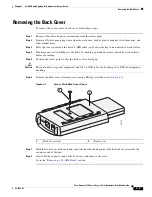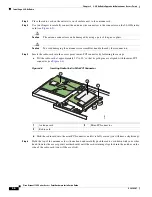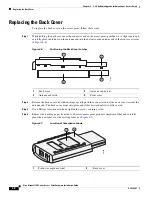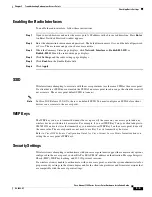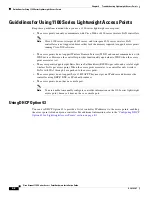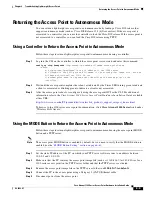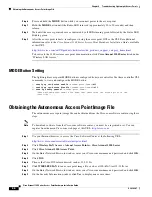
5-4
Cisco Aironet 1100 Series Access Point Hardware Installation Guide
OL-4309-07
Chapter 5 Troubleshooting Autonomous Access Points
Checking Basic Settings
Checking Basic Settings
Mismatched basic settings are the most common causes of lost connectivity with wireless clients. If the
access point does not communicate with client devices, check the following areas.
Default IP Address Behavior
When you connect an 1100 series access point running Cisco IOS Release 12.3(2)JA or later with a
default configuration to your LAN, the 1100 series access point makes several attempts to get an IP
address from the DHCP server. If it does not receive an address, it assigns itself the IP address 10.0.0.1
for five minutes and does not become a mini-DHCP server. During this five-minute window, you can
browse to the default IP address and configure a static address. If after five minutes the access point is
not reconfigured, it discards the 10.0.0.1 address and reverts to requesting an address from the DHCP
server. If it does not receive an address, it sends requests indefinitely. If you miss the five-minute window
for browsing to the access point at 10.0.0.1, you can power-cycle the access point to repeat the process.
When you connect an 1100 series access point running Cisco IOS Release 12.2(15)JA or earlier with a
default configuration to your LAN, the 1100 series access point makes several attempts to get an IP
address from the DHCP server. If it does not receive an address, it assigns itself the IP address 10.0.0.1
and becomes a mini-DHCP server. In that capacity, the access point provides up to twenty IP addresses
between 10.0.0.11 and 10.0.0.30 to the following devices:
•
An Ethernet-capable PC connected to its Ethernet port
•
Wireless client devices configured to use either no SSID or tsunami as the SSID, and with all
security settings disabled
The mini-DHCP server feature is disabled automatically when you assign a static IP address to the access
point.
Caution
When the access point is connected to your LAN, the access point mini-DHCP server provides an IP
address to any DHCP requests it receives.
Default SSID and Radio Behavior
In Cisco IOS Relese 12.3(2)JA2 and earlier, the access point radio is enabled by default and the default
SSID is
tsunami
.
In Cisco IOS Release 12.3(4)JA and later, the access point radio is disabled by default, and there is no
default SSID. You must create an SSID and enable the radio before the access point will allow wireless
associations from other devices. These changes to the default configuration improve the security of
newly installed access points. Refer to the
Cisco IOS Software Configuration Guide for Cisco Aironet
Access Points
for instructions on configuring the SSID and the
“Enabling the Radio Interfaces” section
on page 5-5
for instructions on enabling the radio interface.




